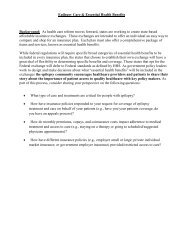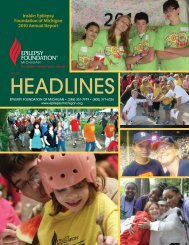Legal Rights of Children with Epilepsy in School & Child Care
Legal Rights of Children with Epilepsy in School & Child Care
Legal Rights of Children with Epilepsy in School & Child Care
Create successful ePaper yourself
Turn your PDF publications into a flip-book with our unique Google optimized e-Paper software.
The Special Education Process for <strong><strong>Child</strong>ren</strong> <strong>with</strong> <strong>Epilepsy</strong>: The Individuals <strong>with</strong> Disabilities Education Act (IDEA)<br />
<strong>School</strong> Board <strong>of</strong> the County <strong>of</strong> Pr<strong>in</strong>ce William v. Malone, 762 F.2d 1210 (4 th Cir. 1985)<br />
The court held that the student could not be expelled for sell<strong>in</strong>g drugs because his action<br />
was a direct manifestation <strong>of</strong> aspects <strong>of</strong> his learn<strong>in</strong>g disabilities, <strong>in</strong>clud<strong>in</strong>g low selfesteem,<br />
desire for acceptance by peers, and a particular susceptibility to peer pressure,<br />
among others.<br />
Honig v. Doe, 484 U.S. 305 (1988)<br />
The Court refused to allow school adm<strong>in</strong>istrators to simply exclude students on the basis<br />
<strong>of</strong> perceived dangerousness, and held that unless the parents consent to an alternative<br />
placement or the school system obta<strong>in</strong>s an <strong>in</strong>junction to exclude the student on the<br />
grounds that the student’s cont<strong>in</strong>ued attendance would be “truly dangerous,” the school<br />
system must permit the student to rema<strong>in</strong> <strong>in</strong> his or her current placement pend<strong>in</strong>g<br />
agreement to an alternative placement or the completion <strong>of</strong> any adm<strong>in</strong>istrative or court<br />
proceed<strong>in</strong>gs to challenge any proposed change <strong>in</strong> placement.<br />
Much <strong>of</strong> the Honig hold<strong>in</strong>g was <strong>in</strong>corporated <strong>in</strong>to the IDEA when it was reauthorized <strong>in</strong><br />
1997 and it was changed significantly when the IDEA was reauthorized aga<strong>in</strong> <strong>in</strong> 2004,<br />
particularly <strong>with</strong> regard to when a student may rema<strong>in</strong> <strong>in</strong> his or her current placement and<br />
when he or she may be removed from school by adm<strong>in</strong>istrators. However, the Honig<br />
decision rema<strong>in</strong>s <strong>in</strong>structive both for what seems to constitute “truly dangerous” behavior<br />
and for the alternatives to suspension that the Court lists. With respect to “truly<br />
dangerous” behavior, it is <strong>in</strong>structive to note the standard had not been met <strong>in</strong> this case.<br />
The Court found that the school district had failed to show a substantial likelihood that<br />
cont<strong>in</strong>ued attendance <strong>of</strong> either student <strong>in</strong>volved would result <strong>in</strong> <strong>in</strong>jury to fellow students<br />
or others: one student had been suspended <strong>in</strong>def<strong>in</strong>itely for chok<strong>in</strong>g a fellow student <strong>with</strong><br />
sufficient force to leave abrasions and for kick<strong>in</strong>g out a school w<strong>in</strong>dow, and the second<br />
student had been suspended <strong>in</strong>def<strong>in</strong>itely for disruptive behavior which <strong>in</strong>cluded steal<strong>in</strong>g,<br />
extort<strong>in</strong>g money from fellow students, and mak<strong>in</strong>g sexual comments to female<br />
classmates. With respect to alternatives to suspension, the Court listed the use <strong>of</strong> study<br />
carrels, time outs, detention, or the restriction <strong>of</strong> privileges.<br />
Light v. Parkway C-2 <strong>School</strong> District, 41 F.3d 1223 (8 th Cir. 1994), cert denied 515 U.S.<br />
1132 (1995)<br />
A school district should not take measures to remove a student from his or her current<br />
educational placement until reasonable steps have been taken to mitigate the student’s<br />
threat <strong>of</strong> <strong>in</strong>jury by accommodat<strong>in</strong>g the student’s disability.<br />
69








